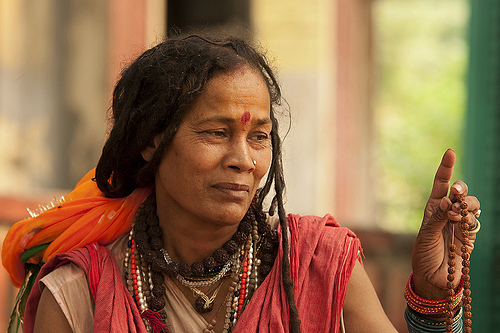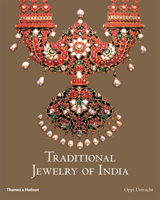 |
|
 |
A female Shiva sadhu (sadhvi) gives blessings to passers by and devotees in Haridwar, India. (Photo: Brett Davies, 2010) |
The antiquity of the Hindu rosary is confirmed by its frequent inclusion with ancient Hindu deities represented in sculpture and painting. Held in a hand, the rosary is meant to symbolize some aspect or attribute of the particular deity, but its meaning is not the same in all cases. Rosaries are included in the depiction of the Hindu deities Agni, Agastya, Ahirbudhnya, Ardhanarisvara, Bhadrakali, Bhringin, Brhaspati, Gauri, Kamantaka, Lakulisa, Manasa, Parvati, Rati, Risi(s), Shiva, Subramanya, Surya, Uma, and Vayu, among others. Lesser spirits are believed to dwell in rosary-bead perforations.
Because rosaries are commonly used by the Hindu laity throughout India, every bazaar of any size features merchants who sell rosaries, which are either hung up or displayed spread out on a ground cloth. When worn visibly by a Hindu, the material used for the rosary bead can indicate the Hindu deity or sect to whom the rosary and its wearer are dedicated. Those not wishing to display such information wear it out of sight under clothing.
The ideal Hindu rosary has fifty beads, which corresponds with the number of characters in the Sanskrit alphabet, starting with a and ending with ksha. These two letters, combined with mala, form the word akshamala, which means "rosary." In Sanskrit, aksha also means grain, seed, or nut—of which many rosaries are made—and mala means a string of beads, garland, or necklace. Reciting or repeating the rosary is called in Hindi mala japna (S: japa, the mental or oral repetition of a prayer [mantra] accompanied by meditation); and consequently a rosary is also called a japamala.
In actuality, the total number of rosary beads may vary among different Hindu sects. For instance, Shaivites often use 32, or double that—64. A common Vaishnavite rosary has 108 beads. There are many other variants.
The Hindu rosary is used as an aid to meditation, to keep the mind from wandering in order to make it concentrate, without distractions, on the meaning of the prayer being recited. Recitation is usually murmured, or silent. Normally when saying the rosary, a Hindu will repeat the name of his or her self-selected deity (ishtadevata). It also may be the mantra that was whispered to a boy by his guru on the day he was initiated into his caste and invested with the sacred thread; thereafter, it is forever kept a secret. The receiver is regarded as the disciple of that guru, who is more revered than a Brahman priest. The guru guides him in all religious and spiritual matters for the rest of his life. The phrase, name, or sound (the latter termed a seed [bija] syllable), is repeated 108 times daily, keeping count with the rosary.
To prevent others from observing the act, and to eliminate personal risk of injury from the possibility of the evil eye falling upon both the rosary and counter, it is common among some Hindu sects to place the rosary and the hand holding it into a small, sometimes embroidered cloth bag while reciting. The bag is called gaumukhi, which means "cow's mouth." These bags are made and sold to pilgrims at the holy city of Varanasi, which gives their ownership a certain prestige.
Gayatri Japam
A widely used Hindu rosary prayer is the Gayatri Japam, repeated twice a day at morning and evening devotions. It is addressed to the sun (Savitar), the supreme generative force and ruler of the planets, to propitiate hostile planets or angry gods. The greater the number of repetitions, the greater their blessing. The favored number of repetitions are 27, 54, or 108 times, without break. Through this repetition, the reciter strives to accumulate an inner force originating from the sun, which illuminates his mind and results in knowledge, energy, and blessings in one's undertakings.
The reciter sits in a quiet place on a seat (S: asana) made of a sacrificially pure substance, reserved only for that individual's use. It can be a darbha-grass mat, a plank of wood of certain trees, wool or silk cloth, a deer or tiger skin.
During meditation, an eight-petaled lotus flower is pictured in the mind. Each petal represents a deity (dikpalaka), each of whom is a guardian of the four quarters and the four intermediate quarters, with the sun at the center. The deities invoked are: Surya (or another of the many Hindu names for the sun), Indra, Agni, Yama, Niruthi, Varuna, Vayu, Kubera, and Isana.
Materials Used for Hindu Rosaries
Materials approved for use in Hindu rosaries are perhaps the most varied of those used among all religions. A wide variety come from the vegetable world and include seeds, berries, fruit, nuts, drupes, dried plant stems, and wood. From the animal kingdom come bone, ivory, horn, coral, shells and pearls; and from mineral sources come glass, semiprecious or precious stones, and metals.
A rosary of gemstones or gold is considered to be one hundred times as auspicious as any other material. A costly rosary (vijayantimala, victory rosary) is made of any kind of hardstone such as crystal, ruby, emerald, sapphire, cat's eye, and even diamond, as well as combinations of these. Glass has also been used in rosaries for centuries. Colors of glass are often chosen because they simulate that of precious stones. Today plastic beads whose color also simulates natural materials have become ubiquitous because of their low cost.
Various materials are believed to embody particular properties. Silver and gold fulfill wishes; coral brings wealth; crystal, good luck; pearls, glory; and shell helps one to achieve fame. Many traditional materials will always continue in use because of their association with a particular Hindu deity. Devotees of that deity believe that the use of these substances is particularly pleasing to the deity concerned. Among different sects devoted to the worship of the same deity, however, the use of a particular material is not uniform throughout India.
Hindu Rosary » Rosaries of India » Traditional Jewelry of India
Oppi Untracht (2008) Thames & Hudson, Inc.


